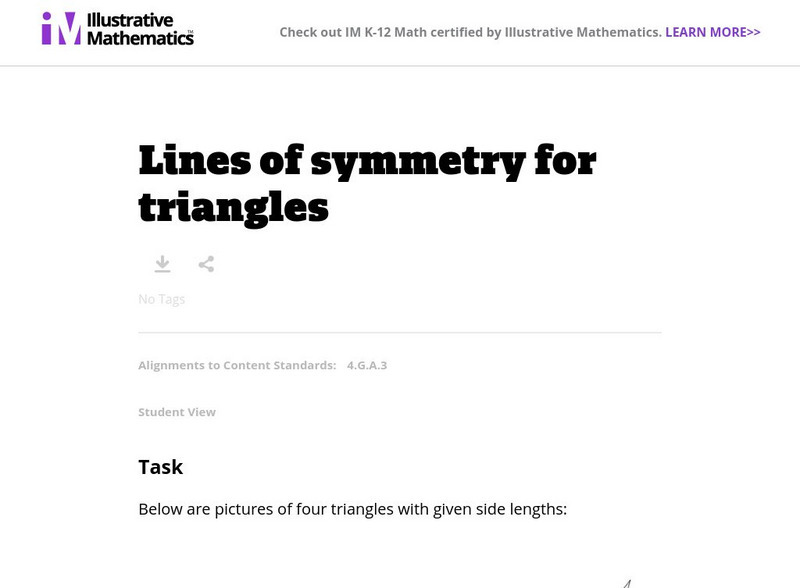Houghton Mifflin Harcourt
Unit 8 Math Vocabulary Cards (Grade 5)
Reinforce math vocabulary with a set of flash cards. With a total of forty-eight cards, each are printed in bold font, and include definition cards that offer a labeled example. Terms include absolute value, ordered...
Curated OER
Tantalizing Tangrams: What Are Transformations?
Students use the Internet to learn about transformations and tessellations. In this geometry lesson, students use the Internet to define the meaning of reflections, translations, rotations, glide reflection and symmetry. ...
Curated OER
Geometrically Artistic/Artistically Geomtric
Students identify the two-dimensional geometric shapes Lowrey utilized in the painting Untitled. Students compare the two-dimensional shapes in terms of equivalent fractions, congruency, symmetry and asymmetry. Students create their own...
Curated OER
Quilt Squared
Students study West Virginia quilts. In this mathematics lesson plan, students use symmetry, geometric shapes, and patterns to create their own quilt square.
Curated OER
Flip's Flag
Fifth graders apply the symmetry and angle properties of polygons and use fractions to express the relationships between the areas of rectangles, squares, and triangles. They analyze various country flags and develop mathematical...
Curated OER
Geometry in Tessellations
Students examine tessellations and their geometric properties. Students explore the concept of tessellations and lines, planes, angles, and polygons. Students experiment with the area and perimeter of polygons. Students analyze...
Curated OER
Visual Patterns in Tessellations
Students explore tessellations as well as various types of polygon. Students examine tessellating patterns in the world around them. Students examine tessellations by creating their own tessellations and completing the included worksheet.
Dick Blick Art Materials
Start with a Circle...
The Golden Ratio. The Divine Proportion. Yup. It's math and art blended into one colorful activity. Young artists combine colored tissue paper circles and parts of circles to create geometric patterns. As a bonus, kids get to figure out...
Curated OER
Drawing to Scale
Students examine the process of drawing a picture to scale. They analyze and discuss real-life blueprints for a house, and create a scale drawing of an original invention using calculators and rulers.
Curated OER
Marshmallow Figures
Learners enjoy making 3-D figures while learning about rectangular prisms, pyramids, vertices, edges, and faces. After a lecture/demo, students use marshmallows, toothpicks and a worksheet imbedded in this instructional activity to...
Curated OER
Triangle Inequality
Students discover that the sum of the lengths of any two sides of a triangle must be greater than the third side. They are shown how a triangle is formed using three strips such as that the triangle is seen inside the strips.
Curated OER
Scaled Rubber Band Drawings
Young scholars demonstrate the process of creating a scaled rubber band enlargement of a simple drawing. They observe and discuss a teacher-led demonstration, and create a scaled rubber band enlargement of simple drawings and their...
Curated OER
Geometry of Democracy
Students explore the architecture of New England by identifying geometric shapes. In this architectural lesson, students examine photographs of classic building architecture and use a transparency to trace geometric shapes they...
Curated OER
Kindness Compliments
Young scholars write compliments for the staff at their school. For this compliments lesson plan, students demonstrate kindness by anonymously writing and taping compliments to people's doors around the school.
Curated OER
Terrific Tessellations
Students explore tessellations that are found in nature and everyday objects. They observe the works of M.C. Escher. Students create their own tessellations using pencil and paper.
Curated OER
Similar or Not?
Fifth graders define the meaning of similar and congruent using concrete objects. They make similar and congruent figures using geoboards. They draw their figures on dot paper, and color their designs.
Illustrative Mathematics
Illustrative Mathematics: 4.g Finding Lines of Symmetry
The purpose of this task is for students to identify figures that have line symmetry and draw appropriate lines of symmetry. Aligns with 4.G.A.3.
Illustrative Mathematics
Illustrative Mathematics: 4.g Lines of Symmetry for Circles
Mr. Watkins asked his students to draw a line of symmetry for a circle with center $O$ pictured below: Aligns with 4.G.A.3.
Illustrative Mathematics
Illustrative Mathematics: 4.g Lines of Symmetry for Triangles
The division of triangles into scalene, isosceles, and equilateral can be thought of in terms of lines of symmetry. Aligns with 4.G.A.3.
Other
Earth Measure: Native American Geometry Designs: Mathematical Landscaping
If you want to plant a class garden, this is a great resource for combining geometry, Native American studies, and rocks.
University of Texas
Inside Mathematics: Fair Play [Pdf]
This task challenges a student to demonstrate understanding of the concept of measurement.
Illustrative Mathematics
Illustrative Mathematics: 4.g Lines of Symmetry for Quadrilaterals
This task provides students a chance to experiment with reflections of the plane and their impact on specific types of quadrilaterals. Aligns with 4.G.A.3.



















